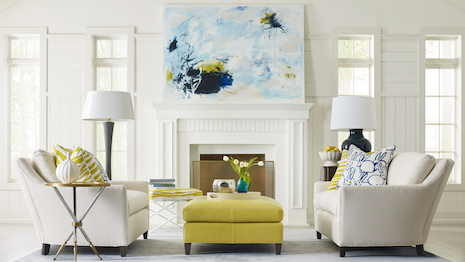- About
- Subscribe Now
- New York,
February 2, 2018

 Ecommerce is up in home improvement. Image credit: Perigold
Ecommerce is up in home improvement. Image credit: Perigold
Increasing consumer confidence, growth in new home construction and the rise of the millennial homebuyer are set to boost the market for home furnishings.
A new report from Brown Gibbons Lang & Company notes that the housing market in the U.S. has been growing 4 percent year-over-year. As consumers build and buy new homes, décor is poised to benefit as consumers seek out furniture and accessories to fill their houses.
"The outlook for the home décor market is highly favorable," said Alexander Teeter, director and principal, head of home environment practice, at Brown Gibbons Lang & Company, Cleveland, OH.
"Macroeconomic forces including general economic expansion, high consumer confidence and a healthy labor market coupled with growth in housing starts, strong housing turnover and household creation and rising home values provide significant tailwinds for home furnishings and décor purchases," he said. "In addition, millennials now make up more than 40 percent of home buyers driving first time purchases for items to go in their new homes."
Going home
In 2017, millennials were 40 percent of homebuyers starting a mortgage, but by the end of 2018, they could represent 43 percent of new mortgage applicants. In 2020, the largest group of millennials will turn 30, which is anticipated to further the generation’s entry into home buying.
Following a healthy 2017, housing turnover is expected to continue this year.
Whether they are moving into a new home or looking to give an existing house a makeover, consumers are growing their spending on home categories.
According to research by Home Accents Today, there was a 2 percent increase in home accents in 2016. Within the $65 billion in sales, area rugs saw the steepest growth of product types, while decorative accessories see the greatest share of purchases.
Claremont Rug Company has seen buyers use area rugs as decor and art. Image credit: Claremont Rug Company
Reflecting consumers’ general move toward ecommerce, online sales of home improvement items grew 41 percent from 2016 to 2017. Those aged 25 to 44 make up the bulk of online home purchases, but boomers and Gen X consumers still account for a significant portion of online sales in the category.
Reflecting the growing interest in buying home goods online, home furnishings group Wayfair Inc. launched a new ecommerce destination for home furnishings aimed at the luxury consumer in 2017.
Perigold opened with a selection of 50,000 items, including linen makers Frette and Sferra and furnishing labels including Ralph Lauren Home, Missoni Home and Swarovski, and it has since grown to retail about 75,000 pieces. Among the approximately 300 brands retailing with Perigold are some that have not sold online previously, representative of luxury’s increasing embrace of ecommerce across product categories (see story).
Along with embracing online, a number of luxury brands, including Gucci and Loewe, have recently added décor lines to their offerings, capturing consumers’ affinities for updating their homes (see story).
Gucci Décor brings the house's codes into the home. Image courtesy of Gucci, illustration by Alex Merry
"An expanding presence online is increasingly critical for any brand seeking growth and relevance," Mr. Teeter said. "Home décor was a relatively late entrant to the market, but recent growth in dedicated online retailers and expanded offerings from omnichannel retailers are driving traffic and consumption.
"As more people research, shop and buy furniture and décor products online, comfort increases and it builds on itself as long as consumer experiences are good," he said. "In order to be successful, the shopping experience needs to be seamless regardless of the type of device used, so investment in Web site design and functionality on computers and mobile devices is important.
"Further, flawless fulfillment from ordering through delivery drive value in the sector. Getting customers to order once is a good start, but investment in the backend operations drives repeat customers and ultimately value.
"Finally, while it can create some channel conflict issues that market participants need to address, the ability to work with third-party ecommerce sites and to go direct to consumers is an important aspect of driving brand value, awareness and loyalty."
Joining up
While home furnishings is still a fragmented category, BGL notes that there has been a lot of M&A activity within the sector in the past year.
For example, in November Eurazeo added upscale candle maker Nest to its stable with a majority stake in the brand. Sold at retailers such as Nordstrom, Saks Fifth Avenue and Sephora, Nest was expecting its 2017 revenues to be between $70 and $80 million.
Last February, Kohler sold its Baker, Milling Road and McGuire luxury furniture brands to Samson.
Chinese financial group Fortune Fountain Capital also offered to buy 88.8 percent of Baccarat’s shares from affiliates of Starwood Capital Group and L Catterton.
The offer, announced on June 2, includes a price per share of 222.7 euros, or $249 at current exchange rates, for a total block purchase of approximately 164 million euros, or $183 million. This acquisition comes as Baccarat is planning further expansion into Asia and the Middle East, with FFC expected to aid the French crystal maker’s international aspirations (see story).
"While the majority of activity in the sector has been focused on the middle and lower ends of the market thus far, high end and luxury brands are likely to see increasing interest as the sector tail winds continue to drive interest in home furnishings and décor," Mr. Teeter said. "Companies offering differentiated, customizable products with high average transaction values will be attractive to private equity investors and industry participants looking to broaden their product portfolios and addressable customer universe."
Share your thoughts. Click here